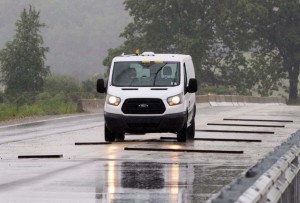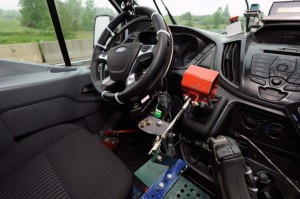We’ve been hearing a lot about autonomous vehicles in recent months, some experts forecasting the first driverless cars could roll into showrooms by the end of the decade – while others say our litigious legal system will never let that happen.
But Ford Motor Co. has already put some robots to work at its big test track in the northern Detroit suburbs, using the technology to handle the repetitive task of test driving vehicles like the new Transit van.
Dave Payne, Ford manager vehicle development operations at the automaker’s proving ground, said the robotic system is now used for more than 70% of the durability testing done at the company’s Michigan Proving Ground outside Romeo, Michigan.
Test drivers are still used for some of the durability tests, Payne stressed, noting that, “The human brain is a wonderful machine.”

The robot driver -- here "manning" a prototype Ford Transit van -- repeatedly tracks the same path within a one inch margin of error.
However, the robotic system, which was first activated last autumn, can handle numbingly repetitive tests time after time without missing a beat, Ford executives said.
“Repeatability is definitely better by the automated driver than human drivers,” noted Jeff Bledsoe, one of the Ford engineers, who worked on the project at the Michigan Proving Ground.
While Ford is one of many automakers looking into self-driving cars that might eventually be sold to the public, that wasn’t the goal here, stressed Payne, who noted there is a separate development team deployed to work on autonomous driving.
“Our objective was to create a test track solution that allows for this type of intense testing that could take our vehicles to the most extreme limits of their engineering while ensuring the safety of all involved,” he explained during a demonstration of the news technology.
Payne said Ford engineers actually took their cues from the mining and agricultural industries, which use robotic systems to guide heavy machinery. The system deployed at the Michigan Proving Ground is the auto industry’s first robotic test driving program and meets demands that Ford trucks undergo ever more strenuous testing with greater frequency.
The pilot program was used most recently for durability testing of Ford’s all-new full-size Transit van, which launches in 2014.
“Some of the tests we do on our commercial trucks for North America are so strenuous that we limit the exposure time for human drivers,” added Payne “The challenge is completing testing to meet vehicle development time lines while keeping our drivers comfortable.”
Robotic testing lets the maker achieve both goals, he added.
“We accelerate durability testing while simultaneously increasing the productivity of our other programs by redeploying drivers to those areas, such as noise level and vehicle dynamics testing.” Payne said.
The durability technology includes a robotic control module installed in the test vehicle that handles vehicle steering, acceleration and braking.
The module is set to follow a preprogrammed course, and the vehicle’s position is regulated by GPS technology that ensures it remains true to course with an accuracy of within one inch. The test track is closed to other vehicles and monitored by camera from a control room more than a mile away. If the vehicles stray from the prescribed course, engineers in the control room can shut it down or move it back on course.
The tests can compress 10 years of daily driving abuse into a matter of months as vehicles jounce along courses just a few hundred yards long, with surfaces that include broken concrete, cobblestones, metal grates, rough gravel, mud pits and oversized speed bumps.
Payne said Ford began studying robotic technology three years in an effort to accelerates testing, allowing an unlimited number of repeat runs until Ford engineers are satisfied with the results. Robots also allow Ford to develop even more challenging durability tests to build tougher trucks. Payne said, adding that another goal was to trim costs.
Ford engineers worked with Utah-based Autonomous Solutions Inc. to design and manufacture the software and components that enable autonomous, robotic operation of the test vehicle.
“We’re very excited to work with Ford for autonomous vehicle testing,” said Mel Torrie, CEO of Autonomous Solutions Inc. “The reliability, durability and performance enhancements we’ve developed with Ford will not only help them reach their safety and accuracy goals, but will also improve vehicle automation in other areas such as mining, agriculture and the U.S. military.”


I can see the lawsuits already…
This just in ,
“Rouge robot driven Ford Atlas escapes company test track crashes into Chevy Silverado test vehicle on Detroit surface street leaves the scene authorities still looking for hit and run bot!
Ford declined comment. “